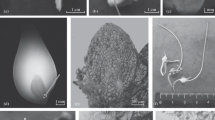Abstract
The feasibility of applying higher plant biotechnology methods and approaches to conservation and propagation of Lilium pensylvanicum is demonstrated. Using seeds as the primary explants enables one to introduce this species into an in vitro culture while not causing harm to mother plants. Subculturing aseptic bulbs on a Humburg medium with halved composition of salts of macro- and microelements and enriched with kinetin (5 mg/L) and indoleacetic acid (1 mg/L) gives rise to the formation of 3 ± 1 bulbs per explant. Subsequent passages on four different variants of culture medium identifies the Murashige and Skoog medium supplemented with 6-benzylaminopurine (0.4 mg/L) as the most suitable for promoting the bulb development and offshoot growth. Rooting is carried out on hormone-free media. Years-long observations over the acclimatization of ex situ regenerated plants have been performed for the first time. The 5-year-long field observations over the survival, growth, and development of regenerated plants (n = 30) under the conditions of the collection nursery of Yakutsk Botanical Garden show that 77% of specimens have been acclimatized successfully. Mass flowering and fruiting is observed to take place in the fourth year. The identified ontogenetic developmental features of young plants are the morphological polyvariety of flowers and a high variability of the stem height. The developed protocol of clonal micropropagation of Lilium pensylvanicum, along with the results of many years of observations over the growth of regenerated plants, suggest that this method can be recommended for propagation of declining cenopopulations.

Similar content being viewed by others
REFERENCES
Stanilova, M.I., Ilcheva, V.P., and Zagorska, N.A., Morphogenetic potential and in vitro micropropagation of endangered plant species Leucojum aestivum L. and Lilium rhodopaeum Delip., Plant Cell Rep., 1994, vol. 13, no. 8, pp. 451–453.
Ling Fei, X., Feng Wang, M., and Dong, L., Plant regeneration from in vitro cultured leaves of Lanzhou lily (Lilium davidii var. unicolor), Sci. Hortic. (Amsterdam), 2009, vol. 119, no. 4, pp. 458–461.
Yarmolinsky, L., Zaccai, M., Ben-Shabat, Sh., Mills, D., and Huleihel, M., Antiviral activity of ethanol extracts of Ficus binjamina and Lilium candidum in vitro, New Biotechnol., 2009, vol. 26, no. 6, pp. 307–313.
Chang, Ch., Chen, Ch-T., Tsai, Y-Ch., and Chang, W-Ch., A tissue culture protocol for propagation of a rare plant, Lilium speciosum Thunb. var. gloriosoides Baker, Bot. Bull. Acad. Sin., 2000, vol. 41, no. 2, pp. 139–142.
Joshi, S.K. and Dhar, U., In vitro propagation from axenic explants of Lilium oxypetalum (D. Don) Baker, an endemic bulbous plant of high altitude Himalaya, Acta Physiol. Plant., 2009, vol. 31, pp. 833–838.
Sahoo, M.R., Devi, M.P., Dasgupta, M., Prakash, N., and Ngachan, Sh.V., An efficient protocol for in vitro regeneration and conservation of Shirui lily (Lilium mackliniae Sealy): A lab-to-land approach to save the rare endangered Asiatic lily species, In Vitro Cell. Dev. Biol.: Plant, 2018, vol. 54, no. 6, pp. 701–710.
Wu, Y., Ma, Y-D., Li, Y., Zhang, L., and Xia, Y-P., Plantlet regeneration from primary callus cultures of Lilium brownii F.E.Br. ex Miellez var. giganteum G.Y. Li & Z.H. Chen, a rare bulbous germplasm, In In Vitro Cell. Dev. Biol.: Plant, 2019, vol. 55, no. 1, pp. 44–59.
Bakhshaie, M., Khosravi, S., Azadi, P., Bagheri, H., and Tuyl, J.M., Biotechnological advances in Lilium,Plant Cell Rep., 2016, vol. 35, no. 9, pp. 1799–1826.
Ault, J.R. and Siqueira, S.S., Morphogenetic response of Lilium michiganense to four auxin-type plant growth regulators in vitro, Hortscience, 2008, vol. 43, no. 6, pp. 1922–1924.
Dhyani, A., Sharma, G., Nautiyal, B.P., and Nautiyal, M.Ch., Propagation and conservation of Lilium polyphyllum D. Don ex Royle, J. Appl. Res. Med. Aromat. Plants, 2014, vol. 1, no. 4, pp. 144–147.
Krasnaya kniga Respubliki Sakha (Yakutiya) (The Red Book of the Republic of Sakha (Yakutia)), vol. 1: Redkie i nakhodyashchiesya pod ugrozoi ischeznoveniya vidy rastenii i gribov (Rare and Endangered Species of Plants and Fungi), Danilov, N.S, Eds., Moscow: Reart, 2017.
Gambourg, O.L. and Elevegh, D., Culture methods and detection of glucanases in suspension cultures of weat and parleys, Can. J. Biochem., 1968, vol. 46, pp. 417–421.
Murashige, T. and Skoog, F., A revised medium for rapid growth and bioassay with tobacco tissue cultures, Physiol. Plant., 1962, vol. 15, no. 3, pp. 473–476.
Beideman, I.N., Metodika izucheniya fenologii rastenii i rastitel’nykh soobshchestv (Methodology for Studying the Phenology of Plants and Plant Communities), Novosibirsk: Nauka, 1974.
Pugacheva, G.M. and Sokolova, M.A., Clonal micropropagation of lilies, Vestn. Michurinsk. Gos. Agrar. Univ., 2010, no. 1, pp. 35–37.
Stepanova, A.Yu., Il’ina, V.S., Staroverov, V.V., and Tereshonok, D.V., Microclonal propagation of Asiatic lily, Plodovod. Yagodovod. Ross., 2011, vol. 26, pp. 237–243.
Ikeda, N., Niimi, Y., and Han, D., Production of seedlings from ovules excised at the zygote stage in Lilium spp., Plant Cell Tiss. Organ Cult., 2003, vol. 73, no. 2, pp. 159–166.
Takayama, S. and Misawa, M., A scheme for mass propagation of Lilium in vitro, Sci. Hortic. (Amsterdam), 1983, vol. 18, no. 4, pp. 353–362.
Osmanova, G.O., Biomorhology of Actaea erythrocarpa Fisch. individuals and ecological-demographic characterization of its cenopopulations, Biol. Bull., 2016, vol. 43, no. 5, pp. 468–473.
Funding
The work was performed within a state assignment to Institute for Biological Problems of the Cryolithic Zone, Siberian Branch, Russian Academy of Sciences, for the years 2017–2020 within project VI.52.1.8 Basic and Applied Aspects of Studies on the Biodiversity of Flora of the North and Central Yakutia (no. AAAA-А17-117020110056-0).
Author information
Authors and Affiliations
Corresponding author
Ethics declarations
COMPLIANCE WITH ETHICAL STANDARDS
This article does not contain any studies involving animals or human participants performed by any of the authors.
CONFLICT OF INTEREST
The authors declare that they have no conflict of interest.
Additional information
Translated by A. Kukharuk
About this article
Cite this article
Filippova, G.V., Darkhanova, V.G., Stroeva, N.S. et al. In Vitro Reproduction and Ex Situ Growth and Development of the Rare Species Lilium pensylvanicum Ker.-Gawl. (Liliaceae). Moscow Univ. Biol.Sci. Bull. 75, 71–76 (2020). https://doi.org/10.3103/S0096392520020030
Received:
Revised:
Accepted:
Published:
Issue Date:
DOI: https://doi.org/10.3103/S0096392520020030




